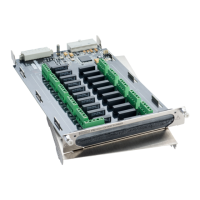10-Channel High Voltage Multiplexer Card User's Manual Section 3:
3762-900-01 Rev. A / July 2017 3-3
Wiring
Because of the high impedance of the board, take special care when handling and using to prevent
degradation of performance. Handle the board by the edges to avoid contaminating it with dirt or
body oil.
Each channel on the 3762 consists of a double-pole, normally open (2 Form A) pair of single-pole
switching relays. The 3762 will switch any one of the 10 signals (inputs) to one output, or switch one
signal to any of one of 10 outputs.
Hazardous voltages may be present on all input, output, and guard terminals. To prevent
electric shock that could cause injury or death, never make or break connections to the
3762 while electrical equipment is powered on. Turn off the equipment from the front panel
or disconnect the main power cord from the rear of the 3762 before handling cables. Turn
off or disconnect any external equipment from the card before removing the card from the
mainframe or changing any connections. Precautions must be taken to prevent a shock
hazard by surrounding the test device and any unprotected leads (wiring) with double
insulation for 1000 volts, Category I.
Wiring is accomplished by means of terminal strips as shown on the component layout (see Wire
selection and preparation (on page 3-2)). Each channel has a HI connection, LO connection, and
GUARD connection. Guard is common to all channels with the jumpers (R201-R210) installed. The
3762 is shipped with all jumpers installed.
1. Wiring is accomplished by means of terminal strips on screw terminals.
2. Resistance of the relay contacts (terminals) path is less than 0.2 Ω.
3. A common guard surrounds all analog signal paths.
4. Use wires or cables that are rated for maximum signal levels. The maximum allowable wire size
is No. 16 AWG and the minimum size is No. 26 AWG.
When operating at high current levels (amperes) consider the voltage burden (I x R drop) of the wire
or cable that is used. For example, the approximate resistance of 24 gauge copper wire is 26 mΩ/ft.
The voltage burden is approximately 26 mV/ft/amp. At the maximum signal current of 1 ampere the
voltage burden would be 26 mV/ft. If the wire being used is 4 feet long, the voltage burden of the wire
is approximately 0.1 V.
5. Route the wires through the rubber clamp pads located at the rear of the card.
Installation and removal
Once the card is wired, insert it card-edge first into the system switch mainframe by aligning it with the
grooves in the appropriate slot. Make sure it is properly seated into the mainframe connector.
To remove a card, first turn off the mainframe and all other equipment connected to the card. Grasp
the end of the card and carefully pull it out of the mainframe.

